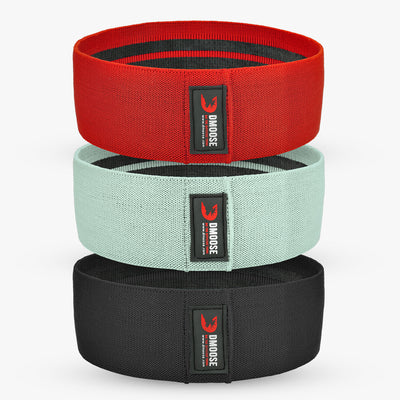In fitness, where sculpting solid and well-defined muscles is the ultimate goal, it's easy for specific muscle groups to go unnoticed and undertrained.
Among these often-neglected areas are the adductor muscles on the inner thighs, which play a crucial role in stabilizing the hips, enhancing lower body strength, and improving overall athletic performance.
While traditional strength training exercises like squats and lunges target the larger muscle groups, the adductors often require specific attention and isolated exercises to reach their full potential. This is where resistance bands come into the picture as invaluable tools for adductor training.
With their elastic and versatile nature, resistance bands provide a unique way to activate and strengthen the adductors, ensuring a well-rounded lower-body workout.
Using DMoose Hip Circle Bands adds extra resistance to help you build stronger, more defined inner thighs while preventing injuries and improving mobility.
This comprehensive guide will explore the 6 best adductor exercises using resistance bands to isolate and engage these often-neglected muscles.
Related Article: Abduction Vs. Adduction: You'll Get a Better Workout if You Know the Difference
Anatomy of Adductor Muscles

The adductor muscles, a collection of smaller muscles situated along the inner thigh, play a vital role in various lower-body movements. Their primary function is to bring the thighs toward the body's midline, aiding in hip stability during exercises and activities such as a hip adductor exercise.
There are several specific muscles within the adductor group, each with unique contributions. The adductor magnus is the most significant muscle, supporting leg abduction, hip flexion, and internal rotation.
The adductor longus, the most superficial muscle, assists in adduction and hip internal rotation. Positioned between the magnus and longus, the adductor brevis primarily aids in thigh adduction but also contributes to flexion, extension, and external hip rotation.
The gracilis, visible on top of the other adductors, promotes thigh internal rotation and flexion. Lastly, the pectineus, a smaller muscle located high in the thigh, assists in adduction and hip flexion.
Understanding the roles and functions of these adductor muscles is essential for targeted training and overall lower-body strength and mobility.
Related Article: The Ultimate Inner Thigh Workout: 10 Best Inner Thigh Exercises for Women
6 Best Adductor Exercises With Bands

Incorporating resistance bands into your training routine can help strengthen and tone your inner thighs effectively. The following band adductor exercises target your inner thigh muscles to improve hip stability, balance, and overall lower-body performance.
1. Standing Leg Adduction
This movement is an effective isolation adductor exercise that focuses on the inner thigh muscles. It mimics the motion of a cable machine but uses a resistance band for a more accessible setup.
How to perform Standing Leg Adduction
- Loop a resistance band around a sturdy post or beam at ankle height.
- Place one ankle inside the loop and stand sideways to the anchor point.
- Pull your working leg across your body, engaging your inner thigh.
- Return slowly to the starting position under control.
- Repeat for reps, then switch legs to complete the set.
For added resistance, step farther from the anchor point to increase band tension. This band adductor exercise helps strengthen your inner thighs and enhances hip stability when performed with proper form.
2. Banded Copenhagen Plank
The Banded Copenhagen plank is a powerful isometric adductor exercise that strengthens the inner thighs and improves stability. It’s particularly useful for injury prevention and developing control during more dynamic lower-body movements.
How to perform Banded Copenhagen Plank
- Secure a resistance band around sturdy posts, beams, or squat rack hooks.
- Get into a side plank position with your upper body supported on one forearm.
- Place your top ankle over the band, keeping your body in a straight line.
- Press the top leg down against the band tension, engaging your inner thigh.
- Hold the position for time, then switch sides and repeat.
This band adductor exercise challenges your core and hip stabilizers while directly targeting the inner thigh muscles. Gradually increase the hold time as your strength and balance improve to maximize adductor exercise benefits.
3. Quadruped Banded Adduction
The quadruped banded adduction is a stable and effective hip adductor exercise performed on all fours. It isolates the inner thigh muscles while minimizing body sway or momentum, ensuring focused activation.
How to perform Quadruped Banded Adduction
- Anchor a resistance band to a sturdy post or squat rack at floor level.
- Get into a quadruped position with hands and knees on the ground.
- Loop the band around the leg closest to the anchor point.
- Pull the working leg inward toward your body, squeezing the inner thigh.
- Control the movement and repeat for reps before switching sides.
This movement strengthens the adductor muscles and enhances hip stability. Performing this adductor exercise regularly helps improve lower-body strength and balance, especially for movements like squats or lunges.
4. Banded-Resisted Adduction Lunge

The banded-resisted adduction lunge is an excellent adductor exercise at home that challenges the inner thighs while improving balance and hip stability. The band’s outward pull forces your adductors to engage as you maintain control during each lunge.
How to perform Banded-Resisted Adduction Lunge
- Anchor a resistance band to a stable post and loop it around your inside leg near the knee.
- Stand sideways to the anchor point so the band pulls your leg outward.
- Step back into a reverse lunge while keeping your front knee aligned with your toes.
- Push through the front leg to return to the starting position.
- Complete all reps on one leg, then switch sides.
This band adductor exercise builds strength and stability in the hip region while engaging your quads and glutes. Focus on slow, controlled movements and proper knee alignment to maximize benefits.
5. Banded Bulgarian Split Squat
The banded Bulgarian split squat is a powerful single-leg variation that enhances depth and tension for greater adductor exercise benefits. It activates the inner thighs, quads, and glutes while promoting balance and flexibility.
How to perform Banded Bulgarian Split Squat
- Place one end of a resistance band under your front foot on an elevated platform.
- Loop the other end over your opposite shoulder.
- Rest your back foot on a bench behind you.
- Lower into a deep lunge while keeping your chest upright.
- Push through your front leg to return to standing, then repeat on the other side.
Keep your torso upright to maintain tension on the band and prevent shifting the load to your glutes or lower back. This hip adductor exercise improves lower-body control, range of motion, and strength through deeper squats.
6. Banded Sumo Squat
The banded sumo squat targets the inner thighs, glutes, and hips. Its wide stance creates a deeper stretch in the adductors, making it a great cable adductor exercise alternative for home workouts.
How to perform Banded Sumo Squat
- Stand wide with toes pointed slightly outward and place both feet on a loop resistance band.
- Pull the top of the band over your shoulders or upper back.
- Lower into a deep squat, keeping knees in line with your toes.
- Push through your feet to stand back up, squeezing your inner thighs.
- Repeat for the desired reps, maintaining balance and control.
This adductor exercise strengthens your inner thighs while improving hip mobility and lower-body power. Adjust the band tension for your strength level and focus on depth for maximum activation.
Sample Adductor Workout Plan
Here’s a structured adductor exercise routine using resistance bands to strengthen and stabilize your inner thighs. These movements focus on improving hip stability, balance, and lower-body strength.
| Exercise | Sets | Reps / Duration | Rest | Focus |
|---|---|---|---|---|
| Standing Leg Adduction | 3 | 15–20 reps per leg | Minimal | Warm-up, activate inner thighs |
| Banded Front Foot Elevated Bulgarian Split Squat | 3 | 12–15 reps per leg | 60–90 sec | Strengthen quads, glutes & adductors |
| Banded Copenhagen Plank | 3 | 30–45 sec per leg | 60–90 sec | Isometric hip adductor strengthening |
Standing Leg Adduction
The standing leg adduction is a simple yet effective band adductor exercise that isolates and activates the inner thigh muscles. Use it as a warm-up to prepare your hips and adductors for more demanding movements. Focus on slow, controlled motion and steady tension throughout each rep.
Banded Front Foot Elevated Bulgarian Split Squat
This advanced hip adductor exercise strengthens the inner thighs, quads, and glutes. Elevating the front foot increases your range of motion and helps achieve deeper muscle engagement. Maintain balance and control, keeping your chest upright and core engaged as you lower and rise.
Banded Copenhagen Plank
The banded Copenhagen plank targets the adductors through isometric contractions, improving strength and stability. By pressing the top leg down against the band tension, you challenge the inner thigh muscles while enhancing hip control and core endurance. Start with shorter holds and progress gradually.
Adjust the resistance of your bands based on your fitness level and recovery capacity. Always prioritize form over resistance, and allow adequate rest between sessions to promote muscle growth and prevent overtraining.
Benefits of Training the Adductor With Bands

If you wish to enhance the strength of your adductors, utilizing resistance bands offers several notable adductor exercise benefits that can improve both performance and stability.
1. Decreased Risk of Groin Injuries
Weak adductors can lead to instability in the hip and knee, increasing the likelihood of groin pulls and strains. By strengthening the adductors, you can protect yourself from injuries during various activities, including sports, gym workouts, and everyday tasks.
You can incorporate DMoose Post-Workout Powder in your diet for faster injury recovery. This specially formulated powder supports muscle recovery, replenishes glycogen stores, and promotes post-workout rejuvenation.
2. Enhanced Hip Performance
The adductors play a crucial role in pulling the legs inward and facilitating internal rotation of the femur. Insufficient internal rotation at the hip can limit the proper movement of the pelvis.
This restriction may hinder your ability to attain safe and optimal positions while engaging in activities like squatting, deadlifting, and running. Strengthening your adductors through a band adductor exercise can counteract these limitations and promote improved hip performance.
3. Improved Balance
The adductors contribute significantly to hip stability, especially when standing on one leg. Weak adductors can disrupt your balance, leading to slower progress and potential knee, hip, and lower body muscle injuries.
You can enhance your balance and stability by incorporating adductor exercises using resistance bands. Standing band adductor exercises, in particular, require additional balance and coordination, resulting in a two-fold improvement in overall stability.
4. Versatile Training Anywhere
Resistance bands enable you to train your adductors without relying on machines or weights. The bands offer adjustable resistance levels, allowing you to modify the tension based on your needs and progress.
This versatility makes resistance bands ideal for warm-ups, strength-building exercises, and training sessions at home or on the go. You can easily carry them in your gym bag or incorporate them into your home workout routine.
Conclusion
Resistance bands are a highly effective and versatile tool for strengthening and activating the adductor muscles. Incorporating adductor exercises with resistance bands into your fitness routine can help reduce the risk of groin injuries, improve hip performance, and enhance overall balance, all while offering the convenience of training anywhere.
Whether you choose standing leg adductions, Copenhagen planks, lunges, or sumo squats, resistance bands provide consistent tension that effectively challenges and strengthens the inner thigh muscles.
By adding these movements to your regular workouts, you can improve lower body strength, hip stability, and injury prevention. Grab your resistance bands and start building stronger, more resilient adductors today.














